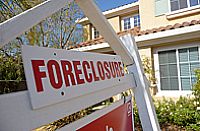Property and Wealth

Lost Futures
The U.S. mortgage crisis made existing wealth gaps worse.
The True American Dream
by Masum Momaya, Curator
For most Americans in the United States, home ownership is the fulfillment of a lifelong dream as well as an essential way to achieve long-term financial security, for themselves and for future generations. But over the past few years, the U.S. has faced a “subprime” lending crisis, in which a flood of high-cost loans has jeopardized home ownership and future prospects for tens of thousands of Americans across the country. In the recent crisis, women and people who belong to racial minority groups have been especially hard hit, worsening longstanding gaps in wealth and economic opportunity. Read more
|
Bounty is an irreverent visual statement on consumption and economic values in the land of plenty--the United States.
|
Using familiar financial language, artist Alina Chau presents a fanciful depiction of the current economic climate in her piece, "Bear and Bull," created especially for Economica.
|
|
|
In the subprime mortgage crisis, women and minorities are losing their homes at a disproportionate rate, disrupting their daily lives and their family's immediate future. But how will these foreclosures affect the fight for equality?
|
The women of DailyWorth.com, a personal finance email for women, offer practical tips and inspired words to encourage all women to recognize our self worth and to create our own wealth.
|
|
|
Peace Musiimenta says that in Africa, owning land means financial stability and independence. So what does it mean that women can't be landowners without a man's approval?
|
In the United States, women lenders suffer discrimination. Anita Hill explores the reasons why women receive subprime loans at a much higher rate than men.
|
|
|
Photographer Lili Almog presents an intimate look at women in rural China, and examines how the rapid modernization of society is changing women's economic opportunities and cultural traditions.
|
Jane Duong says that despite the recent impact of devastating predatory lending practices in the United States, women are taking more control over their financial well-being in this economic crisis.
|
|
|
A new report from the National Council of Negro Women and the National Community Reinvestment Coalition examines the relationship between gender, race and class in U.S. lending practices.
|
The subprime mortgage crisis has affected millions of Americans--but women were hit the hardest. How can we recover? And how can we stop this from happening again?
|
|
|
Historian Karen Offen describes how an economic theory has hindered women's economic growth throughout history, and still limits them today.
|
Carol Ng-He's painting examines the ways that women's bodies are treated as commodities, both historically and in contemporary culture.
|
|
|
Around the world, a billion people live in extreme poverty and struggle to survive. Ritu Sharma goes to Guatemala to find out what it's like living on $1 a day.
|
Artist Mariana Castro De Ali uses bird migration as a metaphor for the ordeal immigrants face daily, and prints her original artwork on used receipts.
|
|
|
Artist Alina Chau presents a mixed-media piece that reflects how everyday people have been affected by the economic downturn.
|
Lisa Link presents this striking performance art video project about the impact of U.S. economic policies of the last ten years on middle and working class women.
|
|
|
How are women of color and low-income women holding up during the recession? And where do they fit into the recovery? The Ms. Foundation for Women explains.
|



















